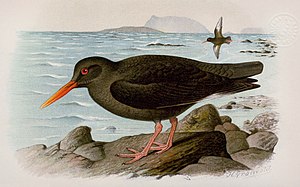Canary Island Oystercatcher
| Canary Island Oystercatcher | ||||||||||
|---|---|---|---|---|---|---|---|---|---|---|

Canary Island Oystercatcher ( Haematopus meadewaldoi ) |
||||||||||
| Systematics | ||||||||||
|
||||||||||
| Scientific name | ||||||||||
| Haematopus meadewaldoi | ||||||||||
| Bannerman , 1913 |
The Canary Oystercatcher ( Haematopus meadewaldoi ), also known as the Canary Oystercatcher , is an extinct wader that was found in the eastern Canary Islands . The art epithet honors the British ornithologist Edmund Meade-Waldo .
features
The Canary Oystercatcher reached a size of 40 to 45 cm. It looked very similar to the black oystercatcher ( Haematopus moquini ), but had smaller wings, a slimmer barrel and a longer beak. The plumage was generally glossy black with a white spot at the base of the inner tassels of the palm. The iris was red, the eye ring was orange, the beak vermilion with a lighter tip. The legs and feet were dark pink, the claws were ivory.
Systematics
David Armitage Bannerman described the Canary Oystercatcher in 1913 as Haematopus niger meade-waldoi . Since Haematopus niger had already been preoccupied for Johann Friedrich Gmelins Scolopax nigra in 1787 , Ernst Hartert suggested the name Haematopus unicolor meadewaldoi in 1921 . In 1934 it was reclassified as Haematopus ostralegus meadewaldoi by James Lee Peters . In 1962 it was classified by Bannerman as a subspecies of the black oyster fisherman ( Haematopus moquini ). In 1982, the ornithologist Phil Hockey showed that the Canary Oystercatcher is different from the Black Oystercatcher and raised the Canary Oystercatcher to species status.
Way of life
Its eggs were smaller than those of the black oystercatcher.
die out
Between 1828 and 1830, the Canary Island oystercatcher was first observed by Philip Barker Webb and Sabin Berthelot on the coasts of La Graciosa , Lanzarote and Fuerteventura . Edmund Meade-Waldo, who made this species known in ornithological circles, caught three specimens together with Henry Baker Tristram in 1893 . During the same period, two more specimens were collected by a local collector named Ramón Gómez. The last known specimen known to have been shot by David Armitage Bannerman in June 1913. According to local reports from fishermen and lighthouse keepers, the Canary Island oystercatcher probably died out around 1940. After four unconfirmed sightings (two from Tenerife and two from Senegal ) between 1968 and 1981 , an extensive search for this species was conducted in the mid-1980s. However, this failed and since 1994 the Canary Islands oystercatcher has been officially listed as extinct by the IUCN .
Over-harvest of invertebrates in the beach zone and human disturbance were believed to be the main reason for its disappearance. In addition, the reenactment by rats and cats probably also played an important role.
literature
- Simon Delany, Derek Scott, Tim Dodman, David Stroud (Eds.): An Atlas of Wader Populations in Africa and Western Eurasia. Wetlands International , Wageningen 2009, ISBN 978-90-5882-047-1 .
Web links
- Haematopus meadewaldoi in the endangered Red List species the IUCN 2008. Posted by: BirdLife International, 2008. Accessed January 30 of 2009.
Single receipts
- ↑ JF Gmelin: Systema naturae I, 2, 1787, p. 659
- ↑ Ernst Hartert: The birds of the palearctic fauna , 1921, p. 2213
- ↑ Peters, James Lee: Checklist of the Birds of the World Volume II Galliformes, Gruiformes, Charadriiformes, Cambridge , Harvard University Press, 1934, p. 233
- ^ Hockey, PAR 1982. The taxonomic status of the Canary Islands Oystercatcher Haematopus (niger) meadewaldoi . In: Bulletin of the British Ornithologists' Club 102: pp 77-83
- ↑ Delany et al., P. 41